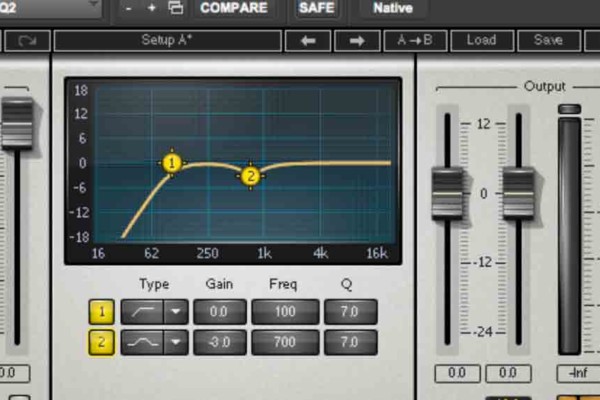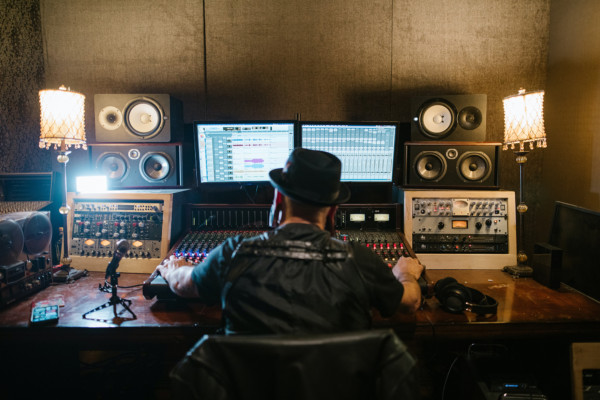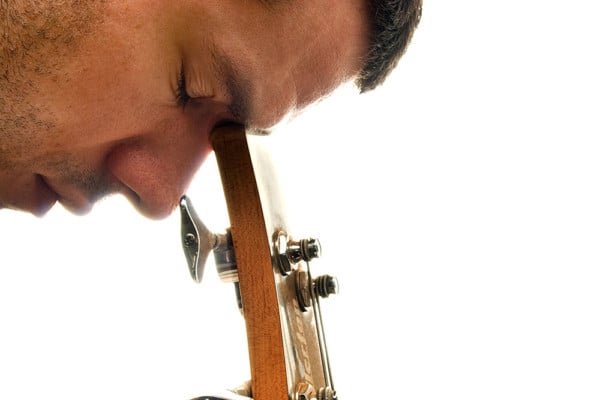Recording the Upright Bass
Steve Bunker, a rockabilly player, recently asked me about the “best way to record the upright bass.” While I don’t think there is any one single way that is the best to record every upright bass in every style of music, I have noticed a few things over the years.
Get your sound before you walk into the studio
This may seem self-evident, but I have met many a bassist who thinks they can walk into a studio with bad tone and no sustain and rely on the audio engineers work magic for them. While engineers can do incredible things these days, I think most will agree that having the right sound before hitting “record” makes everyone’s job easier and the end product better. It’ll also be cheaper.
Work on getting the sound you want when you practice alone and with the group. Get the best instrument you can and polish your tone with proper setup, strings, etc., never forgetting that how you play the bass makes a huge difference. Fine-tune your technique and your instrument so that you can produce the sound you want before the recording date. If amplification is part of your core sound, then work that all out too, so that you are producing the sound you want before you walk into the studio.
Your recording engineer can work with you much more easily if you walk into the studio with a clear opinion on the sound you want, and are able to reproduce it. Be able to say “This is my sound, I want that on the recording.”
Also, go in with a recent re-hair (if appropriate) and fresh – but not brand new – strings… unless you are striving for that dead “thunk” with a lack of sustain.
Amplification and Pickups
Oftentimes a good engineer will have the best ideas on this, and if you have a good engineer it may well be best to defer to their expertise. That stated, in general I prefer a mic in front of an amplifier (provided this is a good sound to begin with!) over a pickup direct into the board or run through studio equipment. Also, if your preferred sound exclusively comes out of your amp, without any acoustic timbre, then I would advise not mixing in a microphone with it. At a minimum, if you want the amplified sound you should be recording the amp. Also, if the amplified sound is even a part of the sound you want, don’t use only a microphone. You will likely be disappointed in the end result.
Acoustic Recording
This is where it can get tricky, if getting the best and most accurate sound of your bass is a priority for any particular session. Often it is not, and priorities are placed on the vocals, guitars, drums or melody instruments. They just set a mic and go. However, if you want the best sound you can get, I have noticed that a process of experimentation is generally needed the first time you walk into a particular studio, or use a specific microphone. With experience, this can be a very short period, but there doesn’t seem to be any template that works for all basses, mics and rooms.
Here are a few suggestions:
- If you have a great sounding bass, you may be able get a good sound fairly simply. Put a single mic around bridge height. Experiment with placement directly in front of the bridge, in front of each F hole and at various distances away from you. Experiment with height as well to find the best sound. Play in all the registers you will be playing in. Also, play bowed, slapped and pizz, as appropriate for the date.
- I have heard great results using a microphone wrapped in a towel, or foam, jammed in between the tailpiece and the belly of the bass. This can add more depth to a thin sounding bass. It can be used as a primary or secondary mic.
- Some basses push a lot of sound out the back or sides, which the player hears. In some cases, I have heard great benefits when a second mic has been placed to pick up sound coming out of the back of an instrument. This can be mixed in with the primary mic in front of the bass.
- If you are recording acoustic rockabilly or other slap bass (i.e. with a tone and a “click”) you might benefit from two mics out front. One near the F-holes, or around the bridge and one higher up to get the “click.”
- Placing a microphone higher up to pick up the sound somewhere on the neck can add great clarity to a bass recording. This can be helpful if you are doing lots of fancy finger work.
- If your bass isn’t great to begin with then you may need more than one microphone and you should experiment with placement until you find an acceptable tone.
- If you get a great sound with one mic, then great! Stop! If not, don’t be afraid to have more than one track devoted to the sound of your bass with various microphones and placements. They can be mixed to help get a tone you are pleased with.
- If you are working with engineers, be nice to them, and be clear in the sound you want.
Good luck!
Dr. Donovan Stokes is on the faculty of Shenandoah University-Conservatory. Visit him online at www.donovanstokes.com and check out the Bass Coalition at www.basscoalition.com.




Anytime I’ve recorded upright in a studio, I have the engineer run a Direct Out from my head, AND set up a mic in front of my cab. It gets a nice mix. But like you mentioned you’ve got to have a good rig, with a good sound, to do it that way… When I record to a digital 8 track recorder at my house, I just run a direct out from my head straight to the Digital 8, & still get plenty of sound control between the pickup, preamp, and head.
What I’ve always found peculiar in articles like these is that hardly any of them says something about the fact that any instrument needs a proper room to sound good. I’ve been in numerous studios that put the bass in a booth that is too small (drummers encounter the same problem) which makes it hard to play like you’re used too, resulting in influencing the sound you’re producing. And if you can’t play and sound like you want to, no engineer or equipment will be able to make it as good as it could and should be.
Hi, I am Tyler Pedersen. If you like West Coast Blues and Jump Blues, I am one of the people
who has been playing and recording it on probably about 25 or 30 CD’s for over thirty years as
a standup bass player
Starting in 2016, I have kind of personalized my sound by playing my own Four guitar-( not
tenor guitar thank you very much). along with my plywood standup bass to a kind of
futurised swing music style-( Swingin, in Space, Swingin’ Beyond. I play standup bass
piano and the Four guitar on that tune. It’s on You Tube as a kind fun video- “ T-Boneasaurus”
In a nutshell, my standup bass sound comes right out of the “swing” sound of 1939 up
to the Willy Dixon sound.
All of us that play this style pretty much use the same approach with the only
real difference is a where we place the notes in the groove. The style consists of only
using quarter notes and half notes that are short and fat. Some people equate this
style with “ rockabilly” but the style is really pre rockabilly and more 1939 swing.
All that clicking and clacking kind of detracts from the cool jump blues soloists of
that sound be it guitar or harmonica- ( William Clark, Rick Holmstrom)
The most important thing about this style is that it is NOT jazz bass in the modern
sense, It is jump and swing standup bass which means that fancy pickup notes
sliding and growling flurries do NOT work in this style
Sorry about kind of sounding like I’m bragging but it’s important for anybody
reading this to know I’m not full of shit
95% of recording up to this point has required the use of a microphone about 6
inches from one of the f holes with a little bass amplification to even it out sometimes.
I use a Wilson piezo pickup system and for the first time I recorded for a project
going completely direct and actually sounded pretty cool. It also helps to have fret inlays
on my standup bass for good intonation. I don’t care what the purists say because
I like having good intonation. I am not classically trained and I would bet most
of the bass players reading this aren’t classically trained either. Having a good
“ feel” is cool but it helps be in tune and I need all the help I can.
Somebody tell me how to fatten the signal in the board to get that fat warm “thump”
to get the Bob Haggard tone-( Woody Herman) without a mike
In an era of lockdowns and whatnot it would be fun to just plug in direct without
any drum bleed.
The weird thing is, that fat kind of “thump” doesn’t seem to exist in the dijital
world. I don’t expect the tone to sound like the old swing records but I can find
it with the help of somebody reading this article.
I think the person that can help me will have a love for the old 40’s stufff.
I think it is the reason early Elvis is so much cooler than Vegas Elvis.
When you think about it the “Roll” in Rock and Roll is that “Thumping”
standup bass.
I either need to route the signal through some kind of analog filter or
something else. I am really close.
Recording that warm “thumping” standup bass directly would be a
Godsend.
No isolation booths or bleed.
Plus the world could start making new music that retains that wonderfull
American Roots, Blues, Swing, Western Swing, Gospel sound.
Actually, my idea worked.
I recorded my standup bass direct just using my Wilson Pickup and it worked great for
a gospel project.
Just make sure your intonation is good and use a V shape setting on a graphic eqailizer eliminating that annoying
midrange sound with just enough top end or clarity and that 40’s tone is achieved. Using
a good tube preamp helps for the final mix.
One has to make sure they basically play quarter and half notes through the songs
with a short percussive pluck. Again, this isn’t rockabilly, so don’t be doing that slapping
thing. Unfortuately, that slap bass thing is better achieved with miking. One can slap a
little in the right places but for God’s sake, by carefull. This isn’t 50’s bass, it’s 40’s bass.
Plus, metal strings with low won’t work either. That high chops, sliding, grinding
jazz tone ain’t it.
I mean no disrespect to jazz players or rockabilly players whatsoever. This particular
approach is pretty much Chess Chicago Blues, 1939 Swing and West Coast
Jump Blues.
I meant to say that that metal string low action sound sound will not work for swing but
sounds appropriate for jazz and jazz fusion
Actually, if you think “ Bluegrass” bass tone, you will pretty much achieve the swing and
west coast tone. One just has to swing a little more with one’s plucking approach.
Remember the “ V “ shape on one’s parametric eq if you are recording direct with
your gut or partial gut string plywood standup bass
Try my idea. It’s as close as anyone can get to that sound direct. Have the producer mike the
speaker to get it to sound even more like the sound of an acoustic sound doing the final mix and mastering
Unless you get a booth there will be bleed in your sound.
Miking the bass is ideal but a lot guitarist, singers etc, will demand using the booth
as they don’t want bleed on there sound.
All good recordings should start by recording the bass and drums first
This whole notion of basses having a lot of sustain seems Ill conceived.
All the great swing bass players had hardly any sustain. Just percussive body resonance.
Even Paul McCartney, James Jamerson and all the old classic electric bass players
had no real sustain, just punch and time.The only time you need sustain is for jazz ballads,
jazz fusion and modern post 60’s jazz. Not my thing but I respect it. Plus, of course, Arco bass.
Plus, slapping and plucking are 2 completely different approaches